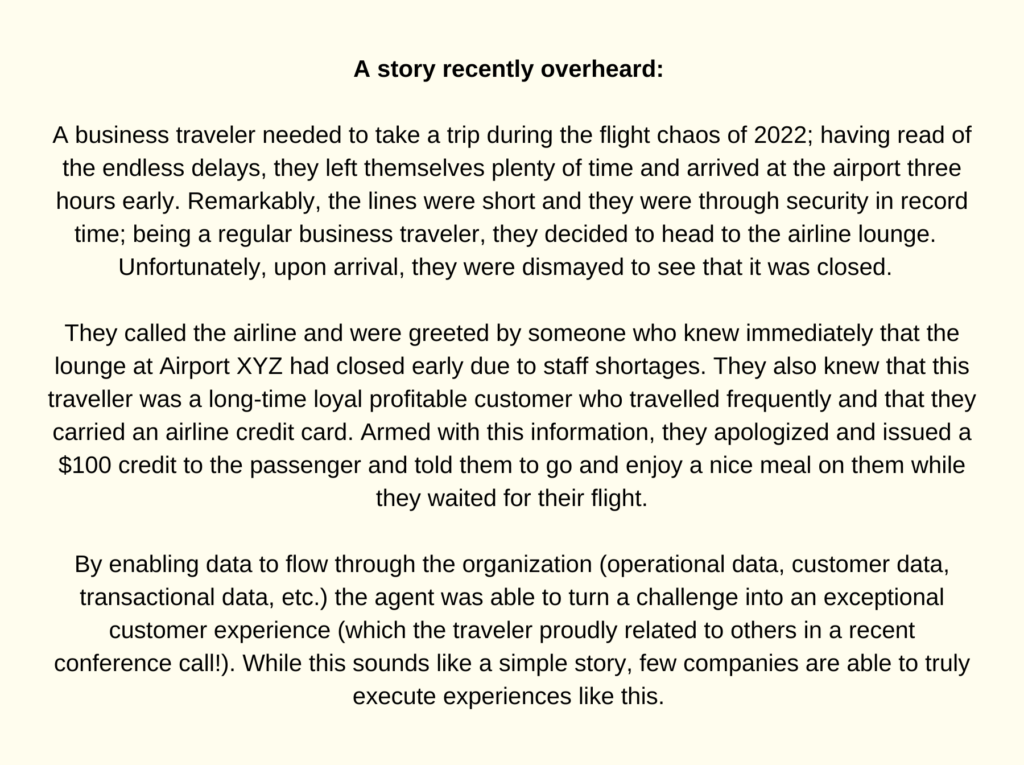The Importance of Data Fluidity

Data is the lifeblood of organizational success in 2023.
Like veins and arteries sending blood around your body, the ability to send clean data across the organization to the people who need it, when they need it, is critical for an organization to function. Blockages in the flow of data can be fatal to the sales and marketing success – or, at very least, cause critical, and perhaps irreparable, harm. Read below to learn the data fluidity definition, how to improve your overall fluidity of data, and more.
What Is Data Fluidity?
Data fluidity allows data to be accessible from any point of exposure, in multiple forms. It is an approach to data that focuses on making accurate data accessible where and when it is needed (through the appropriate technology and processes), making it truly actionable. Data fluidity enables companies to provide customers with a frictionless experience and equips the organization with deep customer insight; it makes customer centric thinking and action possible. Below, we’ve included a scenario where data fluidity improves the customer experience and highlights its usability in an organization.

Accurate – Accessible – Actionable
Achieving data fluidity needs to start with a comprehensive data strategy. Buying technology will not magically create fluidity; in fact, it may actually cause more problems. A comprehensive data strategy needs to focus on the three key elements to data fluidity – accuracy, accessibility and actionability.
Accuracy
There is a well-worn saying Garbage-In-Garbage-Out in the world of data. Never has the accuracy and completeness of your data been more critical. The success of your data fluidity strategy hinges on the quality of your data. Poor data will lead to incorrect decisions which will undermine the efforts you are making to create excellent experiences. Any data fluidity plan should incorporate data assessment, cleansing and improved data intake actions.
Typically, an assessment involves applying a number of lenses to your data….
- Validity – The degree to which your data conforms to defined business rules or constraints e.g. is zipcode five numbers
- Correctness – The degree to which the data is truly correct information e.g. is this the person’s valid zipcode?
- Completeness – The degree to which all required data is known. E.g. is the zipcode field populated?
- Consistency – Ensure your data is consistent within the same dataset and/or across multiple data sets. E.g. is this zipcode the same for this customer across all data silos?
- Uniformity – The degree to which the data is specified using the same unit of measure. E.g. do all systems have a zip+4 format (5 digits) or do some have 9 digits.
Cleansing involves rectifying issues found in the assessment process. This can be a manual process, an automated one or one involving the matching to 3rd party sources to validation.
Perhaps the most crucial part of any data assessment is identifying how to ensure data quality issues do not continue to arise. This is typically done through process improvement; for example, creating pull-down or pick lists for specific fields to ensure only valid answers are permitted, auto-filling information to ensure it is consistent or changing data collection processes with the front line.
Accessible
Clean data is important but only if it can be shared with those who need it. The second key plank to data fluidity is accessibility.
Organs like the heart and lungs are critical to blood flow in the same way that technology can be to data fluidity. Getting data to where it needs to be for decision-making and the orchestration of actions is a key component of a successful data fluidity strategy.
Typically data fluidity is achieved through creating the right tech stack to support it – and doing work to ensure this Tech Stack is fully integrated to enable data to flow in “real time”.
The stack typically includes some or all of:
- A Data Lake or Warehouse
- A Customer Relationship Management (CRM) system
- Marketing Automation / ESP tools
- A Customer Data Platform (CDP)
- Data Visualization or Reporting tools
- Analytic tracking tools (e.g. GA)
- Data science tools
Along specialized marketing tools to support data collection and the orchestration of experiences (social media, intent data, sales enablement, conversational AI etc)… and connections to other business systems like eCommerce and payments.
But the stack alone is not enough, it must be integrated to be effective; we see too many companies with great tools who have skipped this step. A clogged artery or a build-up in the lungs slows down blood flow, and so too does a poorly integrated technology stack or a suboptimally designed CRM system or data lake. Data fluidity is about the connections between data silos and systems and breaking down barriers; these barriers are frequently created when marketing or sales technology is implemented to solve specific problems without a good understanding of its downstream impact.
For example, we often see clients who have implemented a tool like 6Sense to support their ABM strategy; while they have integrated it with their CRM to support sales, they may not have considered integration with their email campaigns and may be missing the complete picture.
Finally, a truly integrated environment will require the right expertise to build it and to keep it running. Marketing operations, technology and platform experts, data engineers, analysts and data scientists are all key parts of the Data Fluidity puzzle.
Actionable
To make data truly actionable, part of your strategy needs to address how data will be consumed at specific touchpoints. Will it prepopulate a form? Be displayed on a customer statement? Be provided to a call center agent as a recommended next sale? Be an element in a dashboard? Or be used to identify a social media audience.
Actionable data allows the recipients to be able to orchestrate the next step and to make data-driven decisions. For example, creating dashboards that illustrate how campaigns are doing allows marketers to determine which strategies work most effectively.
One area we frequently see overlooked is the creation of a single view of the customer – and a common customer key. Customer insights are rarely actionable if data cannot be effectively tied to a single customer across data silos. Proper attribution, campaign orchestration and profiling, customer-level lifetime value and marketing ROI calculations are all contingent on having a clear understanding of the customer across systems. It is often this profile that truly reveals how accurate, accessible and actionable the data really is.
Years ago, I worked closely with the head of customer data for a major Canadian Bank , an individual whose job it was to ensure that data about customers was accurate, accessible and actionable. I will never forget how it was her own personal address change that made her realize their data fluidity problems. Despite being the person that understood where all customer data was stored, she had spent three months trying to make sure her address was changed in bank systems and was still getting mail delivered to the wrong address! In a truly coordinated environment, a customer would make one call to change their address no matter how many products or services they had with the bank; but, in reality, her customer records were disjointed and address fields existed in numerous different disconnected systems. As she said, “if it takes me three months to change my address, what kind of experience must our customers be having?!”
Where do you start?
For most organizations, the road to data fluidity needs to start with an understanding of where they are at today. This involves looking at connections which exist between systems and understanding how data is acquired, stored, and leveraged. We have recently pioneered an approach that begins with what we call a Data Lab; this is a rapid assessment which is focused on identifying blockages and leakage in your data systems while providing actionable insights and a roadmap to enhancing fluidity in the process.
Measuring success can be challenging. Data quality metrics are a good place to start, although they focus mostly on the accuracy components of data fluidity, not on the accessibility and actionability. Typically, the best measures are those directly connected to the strategies you are trying to achieve: Are leads being converted (or are they getting lost)? Are you able to map a customer’s full journey (both pre and post acquisition)? Having baselines and measuring improvements will help you understand the impact of your actions and pave the way for further investment.
The end result
By enabling true data fluidity, organizations can leverage automation, real-time event orchestration and true artificial intelligence to help them identify new opportunities, enable customer experiences and achieve their growth goals. If you would like support in making your data accurate, accessible, and actionable, talk to Shift Paradigm today!





